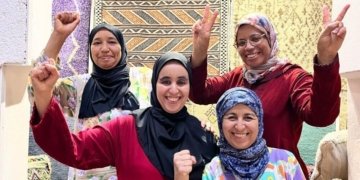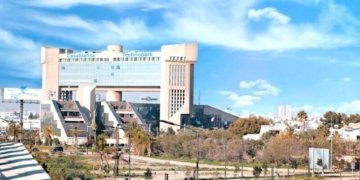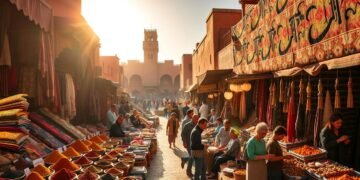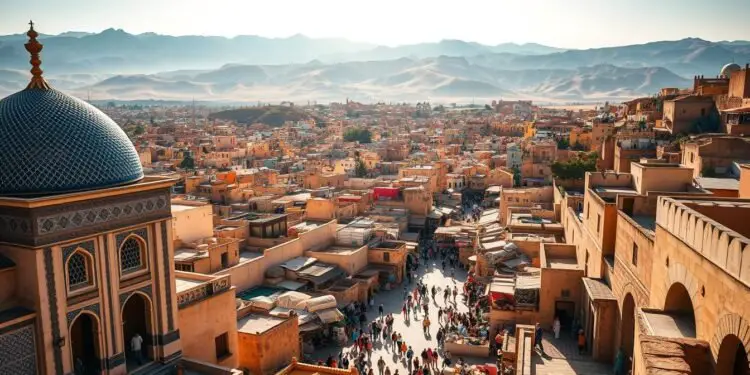Ever wondered what makes Morocco’s cultural capital so mesmerizing? With over 1,200 years of history, Fes blends ancient traditions with vibrant energy. Its UNESCO-listed medina, the world’s largest car-free urban zone, invites you to step back in time.
Wander through labyrinthine alleys lined with handcrafted treasures and aromatic spice stalls. Discover historic madrasas, serene gardens, and rooftop views that steal your breath. This city is a feast for the senses.
Planning a trip here? Two days let you soak in the highlights, from the iconic Chouara Tannery to hidden riad courtyards. Whether you’re between Marrakech and Chefchaouen or diving deep into Moroccan culture, Fes delivers unforgettable moments.
Key Takeaways
- Fes is Morocco’s cultural heart, with a 1,200-year-old UNESCO-listed medina.
- The car-free old town offers walkable streets filled with historic sites and markets.
- Must-see spots include the Chouara Tannery and Bou Inania Madrasa.
- Stay in a traditional riad for rooftop views and authentic charm.
- Two days is ideal to explore top attractions and hidden gems.
Welcome to Fes: Morocco’s Cultural Heart
Few cities capture Morocco’s soul like Fes, where history breathes in every alley. Founded in the 9th century by Idris I, it’s a living tapestry of medieval Islamic artistry and modern vitality. As one of Morocco’s four imperial cities, its black-and-white tilework and labyrinthine medina stand apart from Marrakech’s blue hues.
A Glimpse into Fes’ Rich History
Fes flourished under the Marinid dynasty in the 14th century, becoming a global center for learning. Home to Al-Qarawiyyin University, the world’s oldest degree-granting institution, its scholarly legacy endures. The medina, a UNESCO site since 1981, remains the largest car-free urban zone on earth.
Artisan traditions thrive here, from the 11th-century tanneries to handwoven textiles. The city’s golden age left landmarks like Bou Inania Madrasa, showcasing intricate zellij tilework. Unlike Rabat or Meknes, Fes balances preservation with vibrant daily life.
Why Fes Should Be on Your Travel List
By day, explore souks brimming with spices and leather. By night, rooftop terraces reveal sunset views over the ancient skyline. The medina’s 9,000 alleys hide riads, madrasas, and hidden cafes—each corner tells a story.
As a living heritage site, Fes offers authenticity unmatched by other cities. Its UNESCO status safeguards traditions like calligraphy and pottery. Whether you seek history, culture, or adventure, this Moroccan gem delivers.
Fes What to See: Must-Visit Attractions
Step into a world where medieval craftsmanship meets living history in Fes’ must-see landmarks. Each site tells a story of artistry, faith, and tradition. From leather dye pits to sacred learning spaces, these spots define the city’s soul.
The Iconic Chouara Tannery
The Chouara Tannery is a sensory marvel, operating since the 11th century. Watch artisans dye leather in vibrant pits using lime, saffron, and indigo. Fresh mint leaves handed at entry help mask the pungent aroma.
Multi-level terraces offer panoramic views of the honeycomb-like dye vats. For deeper insight, guided tours explain the 1,000-year-old process. Nearby shops sell high-quality leather goods, from bags to poufs.
Bou Inania Madrasa: A 14th-Century Masterpiece
This 14th-century theological school dazzles with zellij mosaics and a marble courtyard. Its functioning water clock and carved cedar doors reflect Marinid-era brilliance. Arrive early to avoid crowds and admire the geometric patterns in soft light.
The Royal Palace of Fes Doors
Though the palace interior is restricted, its bronze doors are a photographer’s dream. Intricate cedar carvings and geometric motifs showcase Moorish craftsmanship. Visit at golden hour for the best shots of the gilded details.
Exploring the Fes Medina
Dive into the heartbeat of Morocco’s medieval marvel—the Fes Medina. This UNESCO-listed world heritage site thrums with life, its 9,400 alleys weaving a maze of history and commerce. From the iconic Bab Boujloud gate to hidden courtyard mosques, every turn reveals a story.
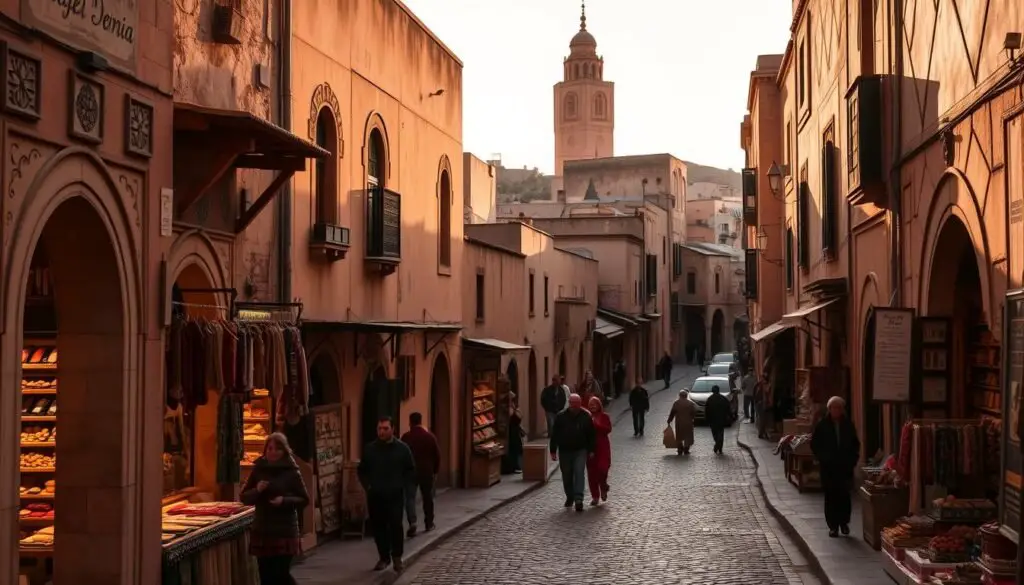
Navigating the medina feels like stepping into a living atlas. Unlike Marrakech’s Jemaa el-Fna, Fes el Bali’s labyrinthine streets are quieter but no less vibrant. Look for distinctive door knockers or hire a guided tour to avoid missing gems like Seffarine Square’s metalworking stalls.
Navigating the Labyrinthine Streets
Don’t fear the medina’s twists—embrace them. Locals use landmarks like the Nejjarine Museum’s carved fountain as waypoints. Gates close around 7 PM, so plan returns before dusk. Pro tip: Download offline maps, but expect to get lost—it’s part of the charm.
Top Souks and Markets to Visit
The medina’s souks are a sensory feast. Attarine dazzles with saffron and cumin, while Kissaria overflows with handwoven textiles. For unique finds, seek the camel butcher’s shop or dyed wool stalls. Compared to Marrakech, bargaining here feels more personal—vendors often share tea and tales.
Hidden Gems in Fes
Beyond the well-trodden paths, Fes hides enchanting spots waiting to be discovered. These lesser-known treasures offer serenity and authenticity away from the crowds.
Ruined Garden Restaurant: A Tranquil Escape
Tucked behind Riad Idrissy, the Ruined Garden feels like a secret oasis. Citrus trees shade stone tables, while rescued turtles wander freely. Sip traditional Moroccan date milk as birds chirp overhead.
Their menu highlights local flavors—think spiced lamb tagine and fig desserts. The attached boutique showcases handwoven textiles, perfect for unique souvenirs.
Al Attarine Madrasa: A Lesser-Known Marvel
Just steps from the spice market, this 14th-century school rivals Bou Inania’s beauty. Cedar wood carvings and cobalt mosaics adorn its prayer hall. Entry costs 20 MAD, and photography is restricted in sacred areas.
Visit late afternoon when golden light illuminates the courtyard. Pair it with Chouara Tannery for a deeper dive into artisan traditions.
Best Rooftops and Views in Fes
Elevate your Fes experience with breathtaking rooftop vistas that frame the city’s skyline. From luxury riads to hidden terraces, these spots offer panoramic views of the medina’s labyrinth and the Middle Atlas Mountains.
Riad Fes: Luxury with a View
This glass-enclosed terrace blends modern comfort with historic charm. Sip mint tea as sunset paints the medina in gold, or book a private dinner under lantern light.
Their elevated position captures minarets and artisan quarters. For photography, arrive during golden hour—soft light enhances zellij tile details.
Dar Seffarine’s Secret Rooftop
Tucked in a restored 14th-century building, this terrace feels like a local secret. Climb to the top for 360-degree panoramas, including Al-Qarawiyyin’s green-tiled roof.
Morning visits reward with quiet solitude. Respect riad etiquette—keep voices low and avoid flash photography near prayer areas.
Other notable spots:
- Cafe Clock: Sunset views with live Gnawa music
- Borj Nord: Free vantage point over the entire medina
- Silk shop terraces: Hidden gems near the university
Where to Stay in Fes
Choosing where to stay in Morocco’s cultural capital shapes your entire experience. The city offers everything from 14th-century riads to modern hostels, each providing unique access to historic wonders. Your accommodation becomes a part of the adventure in this pedestrian-friendly medina.

Top Riads for an Authentic Experience
Riad Fes Maya showcases 14th-century architecture with a central fountain and traditional hammam. At $150 per night, it blends luxury with historic charm. The rooftop terrace offers panoramic views of the ancient cityscape.
Dar Seffarine provides excellent value at $50 per night, featuring hand-carved cedar doors and mosaic courtyards. Many riads include Moroccan cooking classes or traditional breakfasts with local ingredients.
Budget-Friendly Accommodations
Medina Social Club stands out at just $14 per night, perfect for backpackers near Batha Museum. Basic rooms offset by a lively communal atmosphere make it ideal for social travelers.
For slightly more price flexibility, Riad Tizwa offers private rooms with rooftop access. Its location near Bab Boujloud provides easy medina navigation while keeping costs reasonable.
Booking tips:
- Reserve early during peak seasons (April-May, September-October)
- Confirm luggage assistance for medina locations
- Consider noise levels near morning prayer calls
- Verify accessibility if mobility challenged
Getting Around Fes
Navigating Fes requires smart strategies to balance exploration and efficiency. The city offers diverse transport options, from pedestrian alleys to intercity buses. Understanding these systems maximizes your time while respecting local customs.
Mastering Medina Foot Travel
Walking the medina remains the primary way to explore its car-free core. Alleys average 3 feet wide—pack light if claustrophobic. Hand-drawn maps often outperform GPS in these winding streets.
Landmarks like tanneries or mosques make ideal navigation points. Evening walks require caution as some routes lack lighting. For deeper insight, local tours provide context while preventing disorientation.
Taxi and Bus Networks
Petite taxis (blue) operate within city limits—always request meter use or agree on fares beforehand. Twenty dirham typically covers medina-to-station trips. Shared grand taxis (red) serve routes to Meknes or Volubilis.
CTM buses offer reliable day trips with air-conditioned comfort. Parking zones sit outside medina walls for drivers. Evening transport relies on taxis—hotels can arrange late pickups safely.
Key phrases help:
- “Shukran” (Thank you) when exiting shared vehicles
- “Kam min?” (How much?) for fare confirmation
- “La, shukran” (No thanks) to decline persistent drivers
Day Trips from Fes
Venture beyond the medina walls to discover three radically different Moroccan experiences. Within a few hours’ journey, you’ll encounter blue-washed mountain villages, imperial cities, and ancient Roman ruins. These excursions showcase Morocco’s diverse landscapes and layered history.
Chefchaouen: The Blue Pearl
Nestled in the Rif Mountains, this photogenic town dazzles with cobalt-blue buildings. Shared taxis from Fes cost $40-$80 roundtrip, including meal stops. Arrive by 10 AM for soft morning light on the famous staircases.
Respect local customs—some residents decline photography near homes. The Ras El Maa waterfall offers a refreshing hike after exploring the medina. Many guided tours combine visits with stops at Akchour’s natural pools.
Meknes and Volubilis: A Historical Journey
Meknes impresses with its monumental Bab Mansour gate and royal stables. The 40-minute train ride makes this an easy day trip. Pair it with Volubilis, a UNESCO world heritage site featuring remarkably preserved Roman mosaics.
Entry to Volubilis costs 70 MAD ($7)—go early to avoid midday heat. Local guides explain mosaic preservation techniques used since the 3rd century. Wine lovers can detour to nearby vineyards on return trips.
Travel tips:
Private tours average $60-$120 but offer air-conditioned comfort. Groups save 30% on transportation costs.
Border crossings to Algeria require advance visa arrangements.
Moulay Idriss has scenic hiking trails with panoramic views.
Food and Dining in Fes
From street-side msemen to rooftop fine dining, Fes offers a feast for every palate. The city’s food scene blends ancient recipes with bold spices, served in bustling markets or serene riads. Every bite tells a story of Morocco’s rich culinary heritage.
Traditional Moroccan Dishes to Try
Start with lamb tagine at Chez Rachid, slow-cooked with prunes and almonds. Cafe Clock reinvents classics with camel burgers and zaalouk dip. Don’t miss street snacks like msemen (flaky pancakes) or bissara (split-pea soup) in Talaa Kebira.
For a true traditional Moroccan experience, seek pastilla—a sweet-savory pigeon pie dusted with cinnamon. Seasonal ingredients like figs and saffron star in autumn menus. Cooking classes at Dar Roumana teach these dishes using local techniques.
Best Cafés and Restaurants
High-end Nur pairs tasting menus with Moroccan wines, while Dar Hatim serves home-style meals. Budget-friendly spots like Fez Café offer daily-changing menus under citrus trees.
Price ranges vary:
– Street eats: 10–30 MAD ($1–3)
– Mid-range riads: 150–300 MAD ($15–30)
– Fine dining: 500+ MAD ($50+)
Ramadan brings evening feasts; respect fasting hours. For sensitive stomachs, stick to bottled water and peeled fruits. Historic Talaa Kebira street remains the go-to for authentic flavors.
Practical Tips for Visiting Fes
Practical knowledge transforms a good trip into a great one. These insider strategies help visitors navigate cultural nuances and seasonal challenges. From beating the heat to respectful photography, small adjustments create smoother experiences.
Best Time to Visit
Spring (March-May) and autumn (September-November) offer ideal time with mild 70°F averages. Shoulder seasons mean fewer crowds and hotel discounts up to 30%. Summer temperatures can spike to 100°F—plan outdoor activities for early mornings.
Key strategies for hot months:
- Carry UV umbrellas and reusable water bottles
- Book riads with pools for midday breaks
- Visit tanneries before 10 AM to avoid heat reflection
Cultural Etiquette and Safety
Friday afternoons bring prayer day closures at many sites. Dress modestly—knee-length shorts and covered shoulders show respect. People appreciate asking before photographs, especially in artisan workshops.
SafetyWing travel insurance averages $40/month—worth the price for medical coverage. Licensed tours provide reliable guides for medina navigation. Women traveling solo report positive experiences with polite but firm boundaries.
Essential contacts:
- Police: 19 (from local SIM cards)
- Tourist police speak English near Bab Boujloud
- Avoid black market currency exchanges
Conclusion
Exploring this Moroccan gem reveals why it stands apart in the world of cultural destinations. Mastering the medina’s alleys becomes part of the adventure, with each turn uncovering centuries-old craftsmanship.
First-time visitors often leave planning their next trip. The city’s depth rewards repeat exploration—hidden courtyards, artisan workshops, and rooftop sunsets offer fresh things to discover.
Compared to Marrakech’s buzz, this imperial city delivers deeper immersion. Respectful tourism supports local traditions while preserving its UNESCO legacy. Let the labyrinth guide you toward unforgettable moments.
Ready to craft your itinerary? Start with Chouara Tannery at dawn, then lose yourself in the medina’s magic. Every step here connects you to Morocco’s living history.
FAQ
What are the top attractions in Fes?
Must-see spots include the Chouara Tannery, Bou Inania Madrasa, and the Royal Palace doors. Each offers a unique glimpse into the city’s history and craftsmanship.
How do I explore the Medina without getting lost?
Stick to main routes, use landmarks like the Blue Gate, or hire a local guide. The winding streets can be confusing, but getting lost is part of the adventure!
When is the best time to visit Fes?
Spring (March–May) and fall (September–November) offer mild weather. Summers can be hot, while winters are cooler but less crowded.
Are guided tours worth it in Fes?
Yes! A guided tour helps uncover hidden gems and historical insights, especially in complex sites like the medina or 14th-century madrasas.
What traditional Moroccan dishes should I try?
Don’t miss tagine, couscous, and pastilla. For a hands-on experience, consider cooking classes in the medina.
Where can I find the best rooftop views?
Riad Fes and Dar Seffarine offer stunning panoramas. Many riads have terraces perfect for sunset views over the city.
Is Fes safe for solo travelers?
Generally, yes. Stick to well-lit areas at night, be cautious in crowded souks, and respect local customs for a smooth trip.
What’s a unique day trip from Fes?
Chefchaouen, the “Blue Pearl,” is a 3.5-hour drive. For history lovers, Meknes and Volubilis are closer options.
How do I haggle in Fes’ souks?
Start at half the asking price, stay polite, and walk away if needed. Vendors expect bargaining—it’s part of the fun!
Are credit cards widely accepted?
Cash (Moroccan dirhams) is king in markets and small shops. Larger hotels and restaurants may accept cards, but always carry cash.







